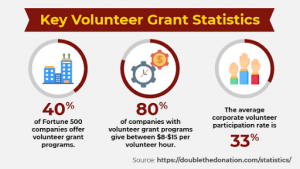Managing Your Event’s Budget: 4 Tips for Nonprofits
Nonprofit events are a staple for any organization trying to make a name for itself and raise money. Throughout the pandemic, you likely postponed or cancelled your organization’s events, making it more challenging than ever to get the word out about your cause and drive revenue. During this time, many nonprofits just like yours were struggling just to stay afloat.
Now, we’re gaining a glimpse at the light at the end of a dark, pandemic-ridden tunnel in which we’ve been stuck for over a year. Slowly but surely, the world is opening back up as more vaccinations are rolled out. It’s about time to start rolling out event invitations for new opportunities at your organization.
However, you want to make sure you conduct each of these events right, with revenue in mind and a well-designed budget. This will help you use these opportunities to once again drive both revenue and brand recognition at your organization.
In this guide, we’ll dive into the budgeting process for nonprofits, discussing strategies to stay organized and make sure you end up in the black. We’ll cover the following four tips:
- Determine a concrete goal for the event.
- LIst out all revenue and expenses.
- Find creative ways to save money.
- Track finances and update your budget.
Jitasa’s nonprofit budgeting guide explains that when you create any budget, whether it’s your annual plan or one for an event, it should carry three distinct characteristics. First, it should have clearly defined activities that relate back to your strategic plan. Second, it should cover a defined period of time, in this case, the time leading up to and during your event. Finally, the metrics you set should be realistic and measurable, defining budgetary details with specific and reasonable numbers.
As you read through the four tips outlined in this guide, look for ways to incorporate these three elements into the provided information.
1. Determine a concrete goal for the event.
Every event your organization hosts should have a goal in mind. It’s the first step on any new event checklist. This goal may be related to the revenue you want to generate, the number of attendees you wish to attend, or any other number of metrics.
Before you start planning your event budget, list out your primary, secondary, and even tertiary goals for the event. Then, whenever you list out an expense for the upcoming event, you can ask yourself, “how will this help me reach one of my goals?” This strategy reduces the amount of unnecessary costs associated with your event, helping you save money and increase your return on investment (ROI).
For example, let’s say you set the following primary and secondary goals for your nonprofit event:
- Primary goal: Raise $200,000 in revenue from attendance during lead-up activities and the event itself.
- Secondary goal: Increase the number of attendees at the event by 10% compared to the previous year, from 2,000 people to 2,200 people.
With these goals in mind, you can determine the priority of different decisions for your event. For example, investing in a new donation tool that allows you to collect both in-person and online gifts will help you raise the goal revenue amount. Or, you might determine that additional Facebook ads will drive more people to your event, helping you reach the secondary attendance goal.
2. List out all revenue and expenses
While this step may be challenging for a brand new event, it’s still necessary to make estimates about your anticipated revenue and expenses during the planning and execution process. This is a key element of creating an effective budget.
As you create this list, get as specific as possible with your estimates. If you’ve held this event in years past, review your receipts and expenses from those years to create the new estimates for this one.
Below, we’ve listed out some potential revenue sources and expenses to give you an idea of what you might include in your own budget:
Potential Revenue
- Event sponsorships and grants for nonprofits
- Peer-to-peer campaign revenue
- Registration or ticket sales
- Event merchandise sales
- Text-to-give contributions made during the event
- Kiosk donations made in-person
- Auction sales
- Raffle ticket sales
Potential Expenses
- Venue booking
- Event catering
- Fundraising software purchase
- Event microsite purchase and configuration
- Registration or ticketing software
- Online venue and software to plan hybrid events
- Auction item purchase
- Social media ads for event promotion
- Flyers to promote the event around the community
- Envelopes and stamps for direct mail invitations
When you plan out these items, keep in mind that some of your revenue may be restricted to very specific aspects of your budget. For instance, you may have a nonprofit grant that can be used for marketing expenses at your event, but not for the purchase of software. Or, you may have donations restricted to specific programs that cannot be used for the event at all.
Accurate financial management and organization will help you determine the correct amount that you have on hand for your event and how you can allocate your funding responsibly.
3. Find creative ways to save money.
Once you’ve listed out your sources of revenue and expenses for your nonprofit event, you’ll have a clear understanding of how much you’ll be spending and how much you’ll raise. This means you’ll be able to calculate the estimated ROI for the event.
If you estimate that you’ll raise more than you spend, that’s great! If not, you might need to rework some elements of your initial estimates. Either way, you can increase your ROI even further by finding some new and creative ways to save money while planning for your event. We’ve listed out some of our favorites below:
Ask volunteers to help with your event.
Instead of relying solely on your staff members to manage your event processes, recruit volunteers to bear some of the heavy lifting. You don’t need to hire extra hands or ask staff members to stay late if you have some additional help setting up auction tables or writing out invitations.
Plus, some of these volunteers may be able to directly increase your event revenue if they’re eligible for volunteer grants. These grants are funds contributed to nonprofits by a company in support of their staff members’ time volunteering. Getting Attention’s volunteer grant guide shows the following statistics about these programs:
- 40% of Fortune 500 companies offer volunteer grant programs.
- 80% of companies with volunteer grant programs give between $8 and $15 per volunteer hour.
- The average corporate volunteer participation rate is 33%.
One reason this participation rate is so low is because supporters don’t realize their own eligibility for these programs. Encourage your own volunteers to research their eligibility for the program to see if they could be helping earn your organization funding while they contribute their time.
Volunteers help your organization financially in two ways. First, you don’t need to hire additional hands or pay overtime for necessary event-related tasks. Second, you might earn additional funding if your volunteers qualify for volunteer grants.
Choose your venue carefully.
One of the most expensive aspects of your nonprofit’s event is your choice in venue. If you choose to host your silent auction in a castle, you’ll need to make a lot of sales to cover the cost of venue rental.
While that’s an exaggeration (you’re probably not hosting your event in a castle), the idea is the same. There are ways you can get creative and choose an event venue that will meet your needs without breaking the bank. For instance, you might decide to:
- Build the event venue yourself. Pitch a tent and in a public park, shut down a city street for the day, or find other ways that you can leverage public spaces to host your event.
- Rethink event activities or setup. Do some of your activities take up a lot of space? There might be a way to cut some of them or reimagine them so that they take up less space. For instance, you might plan to seat guests theater style instead of at round tables.
As you plan your event, list out the potential venues in which you might plan your event. Then, start making pros and cons lists of each. While there are more cost-saving ideas out there about event venues, you don’t want to sacrifice the quality of your event to save just a few bucks. Instead, look for the perfect balance between quality and affordability.
Ask for in-kind donations.
When you raise donations for your event, some of those contributions will need to be spent on event supplies, from food and beverage to chairs and tables. What if you didn’t need to purchase these event supplies, though? You can save funds at your nonprofit by asking for some of these supplies to be contributed in-kind alongside the financial donations you receive.
Consider the following in-kind contributions you might ask for:
- Supplies from your donors. Individual donors might be able to give one-off items that you need. For instance, a single computer or a set of marketing supplies. If you have a long list of one-off items, you might ask donors to purchase something from a wish list to give to your nonprofit in addition to or in lieu of a donation.
- Supplies from corporate partners. Corporations are more likely to be able to give larger numbers of items for your event. Even if they don’t give it outright, they may be able to loan it for the event. For instance, they may provide the multiple chairs and tables you need to make your event possible.
- Services from either donors or corporate partners. You need services to be completed for your event to succeed. For instance, you may ask a graphic design company to contribute in-kind to design a logo for your event. Or, you may ask a writer to help your team compile event marketing materials.
In-kind donations are often just as useful as monetary contributions, especially when you communicate with supporters what it is that you need. Instead of just asking for money, make a wish list of the supplies you need and ask supporters for those items as well to save money on your event.
4. Track finances and update your budget.
Your budget is a living document. Once you create the first iteration of it, that doesn’t mean you’re stuck in a commitment that you can’t escape. Instead, you should record your actual revenue and expenses throughout the event process and make updates to your budget as you go.
Tracking your finances this way will help you see where you’re heading off budget, make adjustments as needed, and ensure you’re remaining profitable. This flexible nature of spending and financing is the backbone of accounting for nonprofits.
When you have the flexibility to make adjustments, you can see why these changes were necessary and create more realistic budgets going forward.
For example, let’s say you save money and expand your potential space for your event by building your own venue in a public park. This makes room for more people and frees up some finances. Therefore, you might decide to reallocate some of the funds you set aside for the venue to spend on additional marketing in order to expand the reach of your event and get more attendees.
Accurate tracking is necessary for future event budgeting. Make sure you keep all iterations of your nonprofit event budget handy and organized so that you can compare your planned vs. actual expenses and revenue sources after the event ends. With this data, you can make next year’s event budget even more accurate.
Events help your nonprofit raise funds and increase brand awareness around the community. In order to make the most of your next event, increasing ROI while achieving all of your goals, you’ll need a well-planned and managed budget.
The tips in this article will help you manage your budgetary expenses and revenue from start to finish. Good luck!
About the Author
Jon Osterburg, Jitasa
Jon Osterburg has spent the last nine years helping more than 100 nonprofits around the world with their finances as a leader at Jitasa, an accounting firm that offers bookkeeping and accounting services to not for profit organizations.










